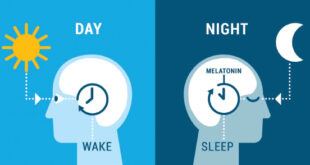“I want to start a weight loss program, but I’m very apprehensive. In the past, I tried a program where I lost about 30 pounds. When I stopped the diet, I gained the weight back quickly, and not only that, I gained more! I’m totally devastated. I don’t know what plan will work and how to keep the weight off for good. Please help!”
Leslie
Dear Leslie,
You are not alone; your experience is unfortunately the norm in weight loss program trends. There is a big difference between weight loss and fat loss, and the goal of many popular diets marketed today is to reduce the number you see on the scale as quickly as possible. However, that number you see glaring at you from the scale is only one number in a combination of numbers used to properly analyze and evaluate your journey to thin. Your success lies in focusing on your body’s overall composition.
The medical and insurance industry focuses on Body Mass Index or BMI. BMI is determined by using your height, weight, and sex. However, BMI does not take in consideration fat%, a more accurate measure of health. Excess body fat creates risk of diabetes, elevated LDL and triglycerides, heart disease, and some types of cancer. Excess fat also produces inflammatory substances in the body effecting joints, arteries, and organs.
To correctly track your journey to lean and to move toward a healthier body, you must know the difference between weight loss and fat loss. The difference is critical and different as apples and oranges. The explanation can be summed up into one phrase I call, The Lean Body Principal. The Lean Body Principal says that the right combination of lean muscle and healthy fat will give you the desired appearance and health you desire.
Following The Lean Body Principle involves first identifying the composition of your body the amount of fat, structural components and lean muscle. You must also understand the amount of energy/calories your body needs to function each day or your Basal Metabolic Rate. Finally your health goals are identified. With this information a strategy can be developed to lead you to your lean body for life.
What is your body fat?
Your body is comprised of three types of fat:
• Structural – necessary to give support to organs.
• Normal – a reserve of fuel, which the body can freely draw upon when the nutritional income from the intestinal tract is insufficient.
• Excess or stored fat – unwanted, unsightly, and dangerous fat filed with toxins.
What is your lean body mass?
Lean body mass is comprised of your skeleton, muscle, organs, and tissue.
What does basal metabolic rate mean?
The metabolic rate is computed by a formula that takes in consideration your age, height, body weight, and activity level and computes the approximate calorie intake your body requires to function and is used to determine needed daily calorie intake. More advanced technology devices can also measure along with individual basal metabolic rate, intracellular water and extra cellular water (which can help determine your fitness level), and other perimeters of overall health. From the analysis and health directives from your primary care physician an individualized nutrition-based and lifestyle modification plan can be developed.
What does the number on the scale
really mean?
As it relates to health and appearance, weight is not nearly as important as the composition of that weight. The number on your bathroom scale is reading your overall weight, how do you know if you are losing fat or muscle? You don’t unless you are working with professionals who use technology to properly measure your composition and identify nutrition plans that target fat loss vs. weight loss.
Reasons to focus on fat loss vs. weight loss:
Why focus on FAT loss vs. Weight Loss?
Weight loss and fat loss are not the same things. Weight loss is very easy to accomplish, simply take in fewer calories than what your body burns on any given day. So if your body burns 1800 calories, and you just take in 1600 calories, weight loss will occur. There is a problem if those calories do not have the right amount of nutrients to prevent weight loss from muscle, bone mass or both. The following are a few reason why focusing on fat loss is so important.
1. Muscle burns fat. If you lose muscle while trying to loss weight, you reduce your metabolism and hinder your body’s ability to burn fat. Muscle loss is the main reason many diet programs fail. Most diets do not provide enough nutrients especially protein to maintain muscle tissue.
2. Muscle weighs more than fat.
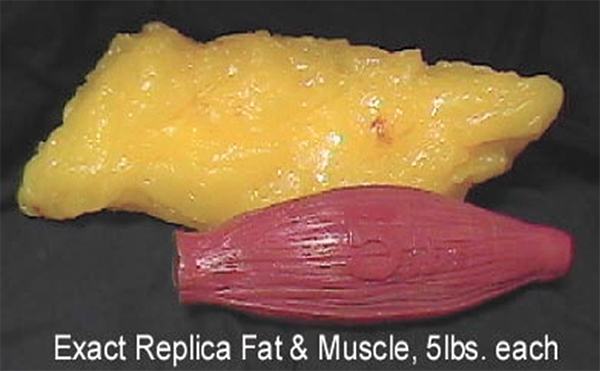
The picture shows 5 pounds of fat and five pounds of muscle. Fat takes up considerably more space than muscle. If you gain muscle density, your body will burn fat faster and be able to keep fat off longer.
3. Losing fat makes you look smaller than losing weight.
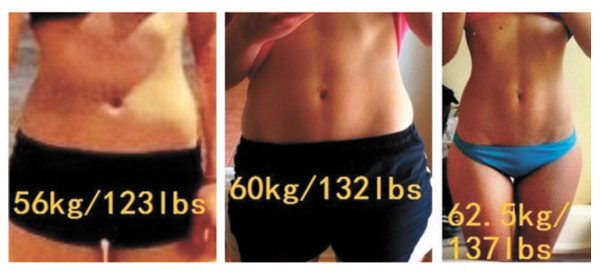 followed on a nutrition plan that targeted fat loss and increased muscle density. While the scale increased her size decreased.
followed on a nutrition plan that targeted fat loss and increased muscle density. While the scale increased her size decreased.
4. A focus on the total weight loss number can be misleading. It is possible for the scale weight to be the same after a week or two of eating healthy and exercise due to the desired result of losing fat and gaining muscle, yet if you are not aware of your body composition, you will think your efforts failed. The reverse can happen as well. Your body can gain fat and lose muscle with a decrease in the total body weight. You will think you lost weight but in reality you lost valuable muscle and increased health risk with more toxic fat.
5. There are other factors that can affect your weight. An over consumption of sodium, not drinking enough fluids, drinking too much fluid, weighing after exercising, hormones, menstruation, and ovulation can affect the number on the scale without reflecting fat loss or gain.
How much fat is healthy?
The following chart shows healthy fat % ranges. These percentages do not take in consideration age, height, and body type; however, they are great starting points. Fat % charts are different from BMI charts they do not take in consideration body fat and muscle density.
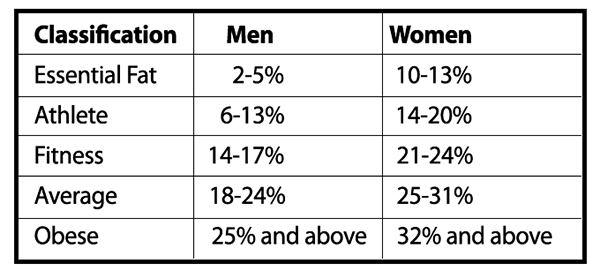
How Body Fat and Lean Body Mass is Determined
So, you want to be the next biggest loser? Here are several ways body fat %, lean body mass and basal/resting metabolic can be determined. Not all of the ways listed provide all the information needed to properly diagnose for health and nutrition recommendations.
Hydrostatic Testing
Hydrostatic testing involves weighting your body in water and is performed in some hospitals and university labs. It is considered one of the most accurate testing measures for body fat and seen demonstrated on the popular TV show, The Biggest Loser. The testing determines body fat and lean body mass in addition to resting/basal metabolic rate. The trouble with this form of testing is availability. It is also not practical for people with disabilities and for children.
Skin-fold Measurements
Skin-fold measuring uses a simple pair of calipers to measure subcutaneous fat, which lies just beneath your skin. While this method is not as simple as standing on a scale, it is more accurate and can easily be done at home.
The method is to pinch a fold of skin between your thumb and index finger, and then use the calipers to measure the thickness of the fold. Repeating this process at several different locations increases the accuracy of measurement.
Though convenient for home use, it does not determine lean body mass, basal metabolic rate and does not calculate muscle loss or gain.
To determine body fat and lean body mass without the use of devices, the following formula can be used:
Lean Body Mass
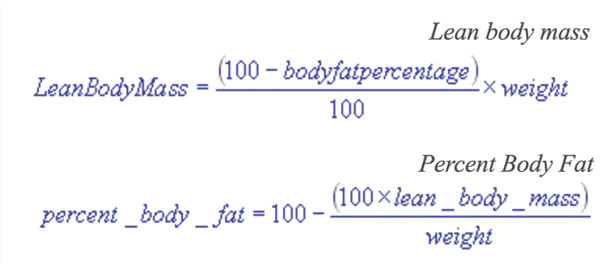 Bioelectrical Impedance Analysis (BIA)
Bioelectrical Impedance Analysis (BIA)
The bioelectrical impedance analysis or BIA is a device that sends a small electrical charge or current through your body and determines the percentage of body fat by measuring the resistance. The determination is based on the fact that muscle, with its high content of water, is more conductive than fat. Thus muscle tends to transmit the current, while fat impedes it.
There are several types of BIA devices from simple to complex and are used with doctor supervised nutrition and weight loss programs. We at Personal Physician Care provide a state of the art device that is FDA cleared, takes only 6 seconds, and can be used easily with all patient populations. The device measures body fat %, lean body mass, body hydration, and basal metabolic rate.
Are you ready for the mind shift?
When it comes to weight loss, focusing on fat loss vs. weight loss is very important. My fat loss journey lead to losing 100 pounds (of fat), being featured in People Magazine, interviewed by Robin Roberts of the Good Morning America Show, and highlighted on ET, was not the result of a quick fix diet. Diets fail because they are often restrictive and only focus on the scale.
My success was due to using strategies instead of will power. I consulted with professionals in the medical and fitness industries and focused on losing fat. By focusing on fat and muscle density, I was able to achieve my ideal body size, fitting into clothing smaller than when I was in my teens, and feeling healthier than I can ever remember.
As a weight loss coach and nutrition specialist, the years of success I’ve had with patients has been due to focusing on lifestyle change and healthy nutrition for life. I teach my patients not to look at the total body weight, but to learn and analyze their body composition for their true success. With a 100% success rate, my patients are happy with their results and have found making the mind shift from weight loss to fat loss, the transition to lifelong success. For questions call Camille at 561-498-5660 ext 346.
Personal Physician Care
561-498-5660 ext 346
www.ppcare.net
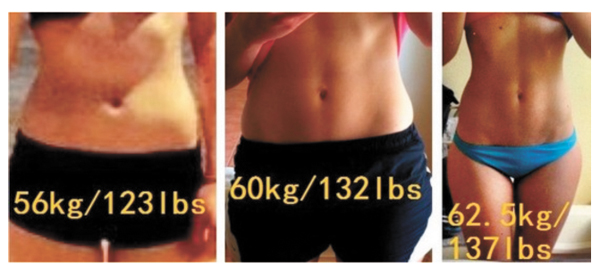
 South Florida Health and Wellness Magazine Health and Wellness Articles
South Florida Health and Wellness Magazine Health and Wellness Articles




